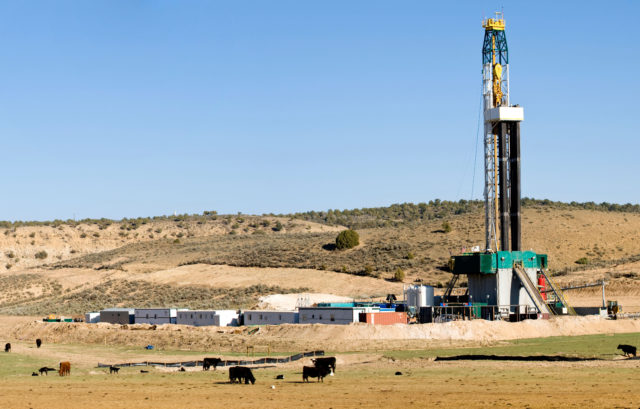
Immediately after his inauguration, Joe Biden got to work on what the Associated Press referred to as “a 10-day blitz of executive actions to redirect the country in the wake of Donald Trump’s presidency…” The intent of these executive orders was to broadcast the priorities of the incoming administration. Environmentalism – energy policy – was most conspicuous among them.
This signalled that the new Administration was on board with the leftward edge of the modern Democratic party, away from the interests of working and middle class Americans, toward those of elites. For such voters environmentalism is a religion of sorts. Showing reverence for the angry climate change gods is necessary, to keep them on-side.
But the real-world costs of Biden’s handing power to the environmentalists – both to individual Americans and to the nation’s international standing – seem to have factored into that calculation barely at all.
Fracking
Fracking is a notable topic where the enmity of environmentalists runs counter to the national interest. The refinement of hydraulic fracturing, where water, sand, and some friction reducing chemicals, (basically soap) are injected at high pressure into the earth to open up tiny fractures in subterranean rock formations liberating the natural ree contained therein, has revolutionized American energy over the past 25 years. This has led to some unalloyed good, including lowering consumer costs while also substantially reducing carbon emissions by transitioning America away from coal to significantly cleaner natural gas.
In this it has been nothing short of a miracle. Due in large part to the fracking boom, the U.S. has led the world in carbon emissions reduction since 2000. You’d think environmentalists would love it.
That is not, however, the case. In fact, because it has undercut the rationale for transitioning to alternative energy sources like wind and solar, while also highlighting their expense, the environmentalist movement has long had fracking in its crosshairs. This has led to the proliferation of anti-fracking propaganda which tends to assert fracking’s culpability in all manner of environmental defilement.
Many of these claims are preposterous – no, fracking won’t make your drinking water flammable. That’s not to say it presents no environmental challenges. It does, particularly issues related to the wastewater that comes back up with the gas. Sensible regulation and technological innovation have helped address these issues. Today much of the water left over from fracking is treated and reused.
Solar and Wind Power
Meanwhile, the proposed alternatives – principally wind and solar power – create their own environmental issues. Wind turbines require 40 to 50 tons of plastic, which is made from petroleum byproducts. They must be replaced every twenty years, and used blades are not recyclable; they are simply dumped into landfills. Solar panels contain toxic chemicals including cadmium, antimony, and lead, which can leach into the soil of landfills, a significant hazard as older panels are decommissioned.
Solar panels also require significant amounts of rare earth minerals and other mined materials, so it isn’t as if they leave the earth untouched. That problem is compounded by the fact that both wind and solar need hundreds of acres of land to generate sufficient amounts of electricity. Additionally, since wind and sunshine are intermittent, traditional – mostly coal-fired – power plants must be kept on stand-by to cover any gaps in the power supply, undercutting any carbon emission reduction wind and solar to which apologists might point.
And then there are the jobs. Fracking has been a boon to the economies of numerous states, including West Virginia and Pennsylvania. At a time when the alienation of America’s working classes has been highlighted by the opioid epidemic and deaths of despair, those trends have been countered by blue collar job growth in the oil and gas industry.
Reducing Jobs
Democrats are sensitive about the suggestion that their energy policies will harm employment prospects among their former voter base. When Biden’s “climate czar,” John Kerry, was asked recently about environmentalist policies endangering jobs, he replied that the Biden administration wants to make it so oil and gas workers “have better choices…. [t]hat they can be the people to go to work to make the solar panels.” Not only was this about as tone deaf as the suggestion that these workers should simply “learn to code,” it failed to account for the fact that such jobs aren’t available, since 70 percent of the world’s solar panels are manufactured in China.
Even if the Biden administration could bring solar panel manufacturing to the U.S., by, for instance, massively increasing the $6.7 billion in annual subsidies which currently make renewables competitive with traditional energy sources in the first place. According to the Energy Information Administration, American fracking has contributed roughly 500 percent more energy to global markets since 2007 than all wind and solar combined. It is improbable that renewables will be able to make up that difference any time soon. Moreover, as energy policy expert Mark P. Mills has observed, ending fracking in America would trigger a global recession, just as the Arab oil embargoes of the 1970s did.
Consequently, when Elizabeth Warren famously promised a total fracking ban if she were elected president, Biden demurred. The talking point he settled on was “No more new fracking!” Perhaps he thought this sounded like a reasonable compromise, but as a policy it falls apart under scrutiny. As Mills noted, fracking, like “manufacturing or farming… is a continual process. So, banning ‘new’ output quickly becomes an overall ban.”
Banning Oil and Gas Leases on Federal Land
Thus far, President Biden has not moved against fracking directly. He has, however, put into motion one of his promises, temporarily banning oil and gas leases on federal land. This is a more dramatic move than it seems. More than 20 percent of America’s oil production and 12 percent of natural gas extraction occurs on federal land. Those numbers go up precipitously when you single out our less populous western states – according to the American Petroleum Institute, federal land production accounts for well over 50 percent of New Mexico’s oil and natural gas production. In Utah and Wyoming, it accounts for 63 percent and 92 percent of their respective production totals.
As those numbers make clear, halting leases will cause massive disruption in the oil and gas industry. It will have serious governmental repercussions as well. As Shawn Regan explained in his recent article The Cost of Not Drilling, “Revenues from energy development on federal land and in offshore waters are a major source of federal income, second only to tax revenue.”
The revenue is divided between the federal government and the states, and while several popular federal programs are funded by these royalties, it is at the local level where their loss will really be felt. Oil and gas revenue account for a full 20 percent of New Mexico’s budget, and much of the $150 million they provide Wyoming is earmarked for K-12 education. A recent study by the University of Wyoming estimated that an extended lease moratorium could cost the states $1.6 billion per year on average.
The “Climate Crisis” and Keystone XL
Still, the costs of the moratorium will take time to become clear, as existing leases remain unaffected. But the “Executive Order on Protecting Public Health and the Environment and Restoring Science to tackle the Climate Crisis,” creates an immediate crisis. This sententiously titled order revoked the permit held by Canadian oil concern TC Energy “to construct, operate, and maintain” the Keystone XL pipeline.
This pipeline is an extension of the existing Keystone system which transports Canadian crude to refineries throughout the United States. In 2008, TC Energy (then known as TransCanada) proposed Keystone XL, which would connect the terminal in Hardisty, Alberta with one in Steele City, Nebraska by a shorter route than their existing connection.
So how did this ordinary project garner such notoriety?
The answer is complicated, but it boils down to the fact that environmentalists were wildly successful in getting the broader public to notice Keystone XL. Though Keystone passed every environmental review it was subjected to, it became a cause célèbre of the left. This led directly to President Obama’s rejecting the project application in 2015 after years of vacillating. During the 2016 election, Donald Trump promised to revive it if elected, which he did. Now it has been cancelled again.
Canada’s Response
This game of political ping-pong has caused tension with America’s neighbor to the north. Reports of Biden’s impending Keystone cancelation dominated headlines in Canada and made the Liberal minority government uneasy. While Prime Minister Justin Trudeau is an environmentalist darling, like any other politician he needs to attend to the facts on the ground, and on the ground KXL’s termination was bad news. As much as Trudeau might wish it were otherwise, Canada has the third largest oil reserves in the world, and its economy is heavily dependent on its resource sector.
In response to the rumors, Canada’s U.S. ambassador released a statement on the government’s behalf, stressing the fact that TC had adjusted Keystone in the face of every critique such that it was now more environmentally sound than when it was cancelled in 2015:
Not only has the project itself changed significantly since it was first proposed, but Canada’s oilsands production has also changed significantly. Per-barrel oilsands [greenhouse gas] emissions have dropped 31 percent since 2000, and innovation will continue to drive progress… Keystone XL fits within Canada’s climate plan at a time when our economic recovery is a top priority.
Ultimately, this plea was unsuccessful – KXL was cancelled and TC Energy immediately fired a thousand construction workers. They also began exploring their options for suing the U.S. government for damages.
They’re supported in that proposal by Alberta’s premier Jason Kenney, who has expressed the frustration of Canadian workers in a way that Trudeau could not. He said:
Let’s be clear about what happened today: The leader of our closest ally retroactively vetoed approval for a pipeline that already exists… directly attacking by far the largest part of the Canada-U.S. trade relationship, which is our energy industry and exports…. This decision was made without even giving Canada the opportunity respectfully to make the case for how Keystone XL would strengthen U.S. national and energy security…. That’s not how you treat a friend and an ally.
The Case for Keystone
What might Canada’s case for the KXL Pipeline have looked like? It would likely have been similar to the case made by the U. S. Chamber of Commerce, which held that building the pipeline would create 20,000 union manufacturing and construction jobs; generate almost $140 million in property tax revenue for state and local governments; and attract an additional $20 billion in private sector investment.
The cancellation redounds to the benefit of nations far less concerned about environmental exploitation and human rights abuses than Canada. U.S. refineries will need to purchase oil from such sources, and with Canada less able to sell her resources, the global supply will tighten, and prices will rise. This will harm consumers, but it will also necessarily increase American entanglement in the messy politics of the world’s petro-states. At the height of the Iraq War, young leftists would chant “No Blood for Oil!” but by cancelling Keystone, a Democratic president has now made American military intervention in the Middle East in the next few years – to ensure oil tankers have unobstructed passage through the Strait of Hormuz, for instance – rather more likely.
The Cost of COVID
COVID-19 has compounded the cost question. With the development of vaccines and the advance of other treatments, the virus appears to be on its way to defeat, but once that has occurred, we will have to come to terms with the devastation the pandemic has wrought.
Unemployment is up, especially among people who can’t simply work from home, and the cost of living has risen as well. Government spending has increased precipitously to fill the gap, while the dramatic contraction of the economy will mean lower tax receipts.
At such a time, it is folly to decimate an industry which sustains so many jobs, keeps energy affordable, and generates so much federal and state tax revenue.
COVID-19 has also complicated the foreign policy equation. Iran has been hit harder than any other country in the Middle East. It is a destabilizing force in the region in the best of times, and it is unlikely that the Khomeinist government will be made more pacific by the disaster.
Meanwhile, China’s management of the virus at its outset, as well as its human rights abuses, are troubling. Despite its poor environmental track record – in 2020 alone, new coal-fired power plants in China outpaced those going online in the rest of the world by 300 percent – China has made itself a dominant force in the wind and solar industry.
President Biden promised to “build back better,” but that requires changing course on energy policy, including prioritizing domestic oil and gas production, and doing business with responsible allies like Canada. Rather than subsidizing China’s coal-fired power plants by investing in their alternate energy tech, America should emphasize our own low or zero carbon energy sources, like natural gas and nuclear.
Tom Finnerty writes about politics and energy policy for The-Pipeline.org, an energy newsletter.





